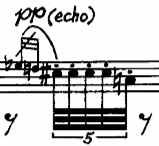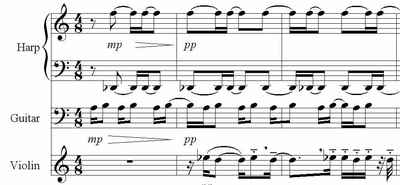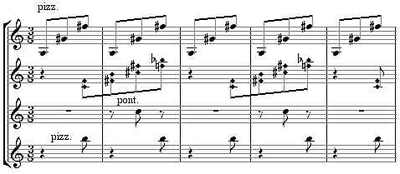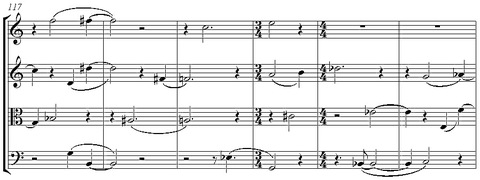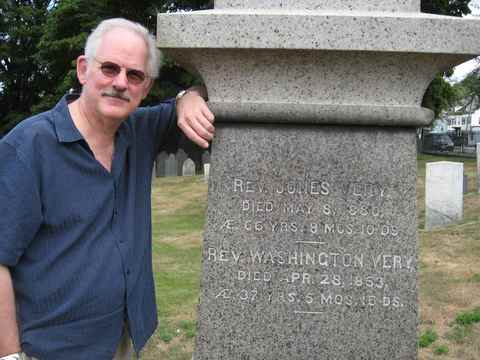I’ve loved George Rochberg’s Serenata d’Estate (Summer Serenade) since I was in high school. Yesterday, for the first time, I finally analyzed it in the classroom. The little repeated-note gestures in the senza battute sections:
Safe Haven for Us Oddballs
Yesterday I had the great pleasure of lecturing on Cage and my own music at the Hartt School in Hartford, at the invitation of Robert Carl and Ken Steen. I’m always joking with them about doing endorsements for the place, and I might as well proceed. Hartt is one of the few graduate schools I recommend for my own students and for those who share my anti-establishment musical interests – others are CalArts, Mills College, Yale, and Wesleyan. But Yale and Wesleyan accept only a tiny number of students and are all but impossible to get into; Hartt has significantly more slots open. Hartt doesn’t seem to have the reputation it did in the mid-20th-century, and I can’t figure out why. I was certainly aware of it as a teenager, possibly because my first composition teacher Alvin Epstein studied and taught there, whereas I was in my 30s before I heard of Bard. One never really knows what goes on in a department from the outside, but the atmosphere there seems enviable, the faculty open-minded and mutually supportive. I’ve sent two students there now, and both of them have been amazed what’s been required from them in learning ear-training, score-reading, and other nuts-and-bolts topics. They take musical education very seriously. The students call it “Boulanger Lite,” and the curriculum does seem copied from the Paris Conservatoire. Nevertheless, it’s one of the few places where one could pursue microtonality, Downtown music, and even conceptualism without drawing down faculty discouragement, PLUS study electronic music in friendlier softwares than Max/MSP and Supercollider. I was very impressed this time with the level and camaraderie of grad students. I got to sit in on Robert’s “Cage, Carter, and Crumb” class, and he was running circles around me in the Cage analysis department. Maybe being slightly underrated is what gives a music department a vibrant energy, while acquiring the “prestige” label turns it into a nest of vipers. If I could do grad school again, I can’t imagine a place I’d rather do it than Hartt.
Thought for the Day
Composer Andrew Violette writes in to tell me that the only movement of 4’33” he really likes is the second. The others, he says, are too short.
An Art Jarvinen Portrait
There were so many sides to Art Jarvinen that I can’t possibly represent most of them here, but I offer several drops from his mercurial musical output, some of them commercially unavailable, others on extremely obscure labels:
Egyptian Two-Step – the first piece I heard, and which made me sit up and take notice with its aerosol spray cans as percussion, performed by the E.A.R. Unit
Breaking the Chink – performed by Icebreaker
from Sgt. Pecker, his Beatles parody:
Taller than Jesus
Man, My Guitar Playing Really Reeks
Where Can I Bury My Shark?
9 Revolutions per Minute
Endless Bummer – with Miroslav Tadik: third track, titled Part 1
25 Lines for 25 Quires – listen closely to the lyrics
The Queen of Spain – third movement, harpsichords and drums, based on Scarlatti
Serious Immobilities – an excerpt from his theme and variations on Satie’s Vexations, the whole thing lasting 24 hours
The Great Art Jarvinen, 1956-2010
[TWO UPDATES BELOW] I begin the morning blindsided by the terrible news that one of the wildest and most imaginative composers of my generation, Art Jarvinen, has passed away at age 54. He was a bassist, percussionist, and co-founder of the California E.A.R. Unit, and one of the most thoroughly integrated rock-classical musicians around. His pieces Murphy Nights and The Paces of Yu were staples of my totalist lectures. He put out a scabrously funny Beatles satire CD called Sgt. Pecker. He sent me transcriptions of music he’d played with Captain Beefheart. I know no details about his demise. Ironically, Art and I had only met in person for one lovely evening together at his home in LA, though for years we corresponded weekly and he used to comment on this blog. He had bought property in Vermont, was supposed to stop by and see me on his way there but we failed to communicate somehow, and I heard a rumor only a few days ago that he had precipitously moved back to California. David Ocker at the blog Mixed Meters has a little more information. Art’s web site is here. I’m just stunned.
In Arthur Jarvinen’s music, spray cans hiss, mousetraps snap, window shutters flicker, pencil sharpeners grind away, and harpsichords cavort among drums with elephantine grace. You may conclude that I am describing gimmicky or at least humorous music, but you would be wrong: this music is contrapuntal, thoughtful, purposeful, and rhythmically intricate. It’s just that Jarvinen works with musical ideas so essentially rhythmic that spray cans and window shutters are sufficient to bring their essence across. I’ve always had this idea that a really great musician, stranded on a desert island, could make a good piece just hitting two sticks together, and Jarvinen lends credence to the idea. The more humble media you can communicate with, the closer you are to the bone marrow of music.
Again, though, put aside any notion of an American primitif. Jarvinen’s The Queen of Spain – source of the harpsichords and drums mentioned above – is an almost satirical transformation of three keyboard sonatas by Domenico Scarlatti, scored for harpsichords (or electric keyboards) and percussion. He diffracted Scarlatti’s transparent harmonies by adding mathematically-derived extra tones, keeping the rhythmic character of the original but blurring the lines into massively bouncing sonorities. And in Murphy-Nights, the electric keyboard and bass provide a groundwork for four wind players by playing two ostinatos over and over, one in 33/16 meter and the other in 8/4, so that with each repetition one gets a 16th-note ahead of the other.Â
I have no idea how this latter feat is accomplished in performance, by the way. No common bar lines connect the two parts: they just have to start with the same 16th-note pulse and keep precisely in tempo, sans conductor. Somehow on the California Ear Unit’s recording (O.O. Discs 28) they get it perfect and secure.
This latter trick, abstruse as it may sound, actually points to what connects Jarvinen to his generation. If you’re minimalism-conversant, it may have already occurred to you that that 33-against-32 cycling is a direct descendent of Steve Reich’s Piano Phase and Come Out, which introduced different-lengthed rhythms going out of phase as a peculiarly American structural device. Like many American composers born in the 1950s, Jarvinen absorbed Reich’s lessons well. Also like many of those composers, he sees no reason to limit his music to the simple contexts and pretty tonalities that formed the basic features of minimalist style.
The body of music by younger composers that evolved from minimalism to a complex rhythmic style heavily influenced by world musics has come to be called Totalism. It is primarily a New York City phenomenon, but Jarvinen, rooted in Los Angeles, is the most visible West-Coast example so far. The word totalism (far from universally accepted yet) has implications of having your cake and eating it too, being accessible and clear on one hand, yet also intricate and complexly structured enough to sustain the interest of cognoscenti. As Mozart wrote to his father about the quartets he was writing in 1782, the totalists can say of their music, “There are many passages here and there from which connoisseurs alone can derive satsifaction; but these passages are written in such a way that the less learned cannot fail to be pleased, though without knowing why.”Â
Without courting collage, totalists pack a lot of disparate streams into their music, especially jazz and world musics: listen to the jazz trombone solo that opens Jarvinen’s Erase the Fake; the improvised violin solo in the middle of Murphy-Nights; the charmingly authentic, Piazzola-esque melody of his Cheap Suit Tango. Some features, however, are quintessentially totalist. I direct your attention to the wild unison line played by sextet at the beginning of The Vulture’s Garden. or the jazzy unison melody played by quartet in Murphy-Nights. This kind of ensemble doubling evolved out of the Philip Glass-Steve Reich ensemble concept (though Messiaen’s Quartet for the End of Time is a first cousin), and is turned here toward athletically non-minimalist ends.
This is difficult music to play, even though clear-lined, melodic, and devoid of the 11-against-9 grupetti and rhythmic fragmentation of an Elliott Carter or a Pierre Boulez. And why, since it scorns such complexities, is it so difficult? Because, like every new style, it demands of performers a certain sensibility that must be internalized. The unison lines and rhythms of totalist chamber music entail an ensemble unity of gesture quite different from the heavily-counted Babbitt serialist work or the flexible, diversely-functioned give-and-take of a Schumann piano quintet. The smooth uniformity of line, casual yet without swell or nuance, demands ears nurtured on the minimalism of Terry Riley and Phillip Glass, and hands and lips that can swing like John Coltrane.Â
If I may ascend my soap box and preach just the briefest sermon, very few chamber ensembles have learned to negotiate music derived from minimalist influences because they don’t perceive the difficulties involved. They glance at the score, see a line of unison 8th-notes, say to themselves, “Oh, this is nothing, I played the Carter Fourth String Quartet,” and then they proceed to underrehearse and perform miserably. I’ve heard it all too often. I’ve heard members of the New York Philharmonic do a laughable job on a piece as simple as Terry Riley’s In C. A handful of groups, like the California EAR Unit, Relache, Kronos Quartet, and Essential Music have superbly cultivated the technique needed for post-minimalist music. What are the rest waiting for, a message from God? As Schoenberg said – and it applies again in each new generation – “My music isn’t modern, it’s only badly played.”
You won’t find any such problems, however, on Jarvinen’s CDs, mostly performed by the California EAR Unit, of which Jarvinen is a percussion-hitting and guitar-wielding member. For the most extreme instance of his bizarre timbral imagination, listen to The Paces of Yu, scored for mousetraps, window shutters, fishing reel, and – the one pitched instrument – Brazilian berimbau, a kind of one-stringed violin. Such music has the awkwardness of sincerity. It is meditative, not in the hypnotic sense, but in the thoughtful, slowly-turning, Emersonian sense of examining a musical idea from every angle. Jarvinen is sufficiently immersed in history to be a true representative of his generation – and honest and original enough to set himself apart from it as well.
Cakes for Oneself
I was happy to read this in the New York Times, in an essay by novelist Michael Cunningham (The Hours):
I teach writing, and one of the first questions I ask my students every semester is, who are you writing for? The answer, 9 times out of 10, is that they write for themselves. I tell them that I understand — that I go home every night, make an elaborate cake and eat it all by myself. By which I mean that cakes, and books, are meant to be presented to others. And further, that books (unlike cakes) are deep, elaborate interactions between writers and readers, albeit separated by time and space.
I remind them, as well, that no one wants to read their stories. There are a lot of other stories out there, and by now, in the 21st century, there’s been such an accumulation of literature that few of us will live long enough to read all the great stories and novels, never mind the pretty good ones. Not to mention the fact that we, as readers, are busy.
We have large and difficult lives. We have, variously, jobs to do, spouses and children to attend to, errands to run, friends to see…
What the writer is saying, essentially, is this: Make room in all that for this. Stop what you’re doing and read this. It had better be apparent, from the opening line, that we’re offering readers something worth their while.
I should admit that when I was as young as my students are now, I too thought of myself as writing either for myself, for some ghostly ideal reader, or, at my most grandiose moments, for future generations. My work suffered as a result.
He describes meeting a very tired divorcée named Helen, holding down three jobs, whose only great diversion in life was reading:
Helen had no school-inspired sense of what she was supposed to enjoy more, and what less. She simply needed what any good reader needs: absorption, emotion, momentum and the sense of being transported from the world in which she lived and transplanted into another one.
I began to think of myself as trying to write a book that would matter to Helen. And, I have to tell you, it changed my writing. I’d seen, rather suddenly, that writing is not only an exercise in self-expression, it is also, more important, a gift we as writers are trying to give to readers. Writing a book for Helen, or for someone like Helen, is a manageable goal.
Unlike Cunningham, I have never said that I wrote for myself. I always liked Gertrude Stein’s declaration, “I write for myself and for strangers” – because it embarrassed her to have friends read her writing – but in truth I am disappointed if my music is playing and a passerby, any passerby, doesn’t stop to ask, with a twinkle of curiosity, “What is THAT?” I write music that I want to hear, of course, but there are musics that I myself dearly love, like those of Phill Niblock and Stefan Wolpe, that I would never write, because they are esoteric enough to seem predestined for only a narrow specialist appeal, even though it’s wide enough to include me. If that makes me a middlebrow composer, then I’ll proudly wave the middlebrow banner. “I write for myself” is one of those self-defeating clichés that academia acculturates young composers into, like “The music should speak for itself!” I can’t imagine that any young artist starts out thinking that his work need only bring pleasure to himself. It’s a defense to be used against having failed to engage the interest of others, which happens to us all now and then.
I also liked Cunningham here:
Here’s a secret. Many novelists, if they are pressed and if they are being honest, will admit that the finished book is a rather rough translation of the book they’d intended to write. It’s one of the heartbreaks of writing fiction. You have, for months or years, been walking around with the idea of a novel in your mind, and in your mind it’s transcendent, it’s brilliantly comic and howlingly tragic, it contains everything you know, and everything you can imagine, about human life on the planet earth. It is vast and mysterious and awe-inspiring. It is a cathedral made of fire….
A novel, any novel, if it’s any good, is not only a slightly disappointing translation of the novelist’s grandest intentions, it is also the most finished draft he could come up with before he collapsed from exhaustion. It’s all I can do not to go from bookstore to bookstore with a pen, grabbing my books from the shelves, crossing out certain lines I’ve come to regret and inserting better ones. For many of us, there is not what you could call a “definitive text.”
This is partly why I can’t get into highly detailed notation. I put staccato dots on a few notes and call a piece finished, and the next day I wake up and look at it and say, “No no, that should be legato!”, and draw in a slur instead, and afterward I’ll change my mind again. The piece changes for me too much in my head to try to obsessively pin it down with interpretive markings. The score is a guide, like lines in a play, not a fixed objet d’art.
Such things should be admitted in the music world more often, and would be, if we were more concerned with being artists and less with being professionals.
The Rest Is Sometimes Silence
Alex Ross has penned a long, informative essay on John Cage in this week’s New Yorker (subscription required to read the whole thing, but you all subscribe, right?) which kindly quotes my 4’33” book at various points. More informatively to me, it also relies heavily on the new biography of Cage, Begin Again by Kenneth Silverman, which looks to be admirably thorough and chock full of new information, and which Amazon lists as due to appear Oct. 19. One bit I didn’t know: I’m on record as being a little dubious about Schoenberg’s having supposedly called Cage his best American student (“an inventor – of genius”), but apparently Cage was the only American student to attend a private 1937 reading of Schoenberg’s Fourth String Quartet at Schoenberg’s home. Curious.
My Chicago Roots
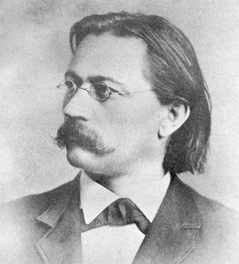 I’ve always had a fascination with canons, even long before I wrote a book about a composer (Nancarrow) whose major works were mostly canons. In the late 1980s, when I was in the habit of lecturing on the history of Chicago’s new-music scene at the School of the Art Institute and other places, I ran across, in a Chicago used bookstore, a little book called Canonical Studies, by Bernhard Ziehn (1845-1912, pictured). I recognized the name. Ziehn was one of two German composer-theorists who were living in Chicago when Ferruccio Busoni toured through. Busoni was trying to solve the puzzle of how the four fugue subjects
I’ve always had a fascination with canons, even long before I wrote a book about a composer (Nancarrow) whose major works were mostly canons. In the late 1980s, when I was in the habit of lecturing on the history of Chicago’s new-music scene at the School of the Art Institute and other places, I ran across, in a Chicago used bookstore, a little book called Canonical Studies, by Bernhard Ziehn (1845-1912, pictured). I recognized the name. Ziehn was one of two German composer-theorists who were living in Chicago when Ferruccio Busoni toured through. Busoni was trying to solve the puzzle of how the four fugue subjects
fit together in the unfinished fugue from Bach’s The Art of Fugue, and Ziehn solved it for him, enabling Busoni to write his Fantasia Contrappuntistica, which has long been one of my very favorite works in the world. His tour over, Busoni wrote an article about Ziehn and his colleague Wilhelm Middelschulte, titled “The Gothics of Chicago,” by which term he meant that they were masters and fanatics in the ancient art of counterpoint. Ziehn and Middelschulte taught a lot of the early Chicago composers, including John J. Becker (one of the “American Five”), whose widow I knew in Evanston. So I had multiple connections to Ziehn, and snapped the book up at once.
All but forgotten today (there’s a brief entry about him on German Wikipedia, none in the English one, and the second reference that came up on Google was a page of my own), Ziehn was ahead of his time. Books he published in the 1880s anticipated and classified chords (such as those based on the whole-tone scale) that the impressionists and Schoenberg would use considerably later. In the intro to Canonical Studies, Ziehn writes,
A canon is by definition strict. Our greatest authorities assert “strict” canons can be carried out in the Octave of Prime only. The examples given in this book demonstrate that real canons are possible in any interval…
And he gives examples of chord progressions that modulate to every possible interval away from the tonic, showing how one can continue repeating those progressions in ever-moving transposition to write canons not based on the octave or unison.
I was intrigued, and in 1987 wrote what I call a “spiral canon” as the third movement of my violin piece Cyclic Aphorisms, a canon at the major second. Then, more ambitiously, in 1990 I wrote Chicago Spiral, a nine-part triple canon also at the major 2nd, putting a postminimalist spin on Ziehn’s idea. A canon is easy to perceive as such at the unison, octave, or even fifth; it’s more
challenging at a more distantly related interval. A canon is also easier to process aurally if the beat-interval of rhythmic imitation is something symmetrical like 4 or 8 beats, more difficult if it’s 13 or 31. One thing I’ve realized is central to my music is that I love to fuse the simple with the incommensurable, making the listener think it ought to be easy to figure out what’s going on, but keeping it just out of reach. My Ziehn-inspired spiral canons ought to be simple to figure out by ear – they’re only canons, after all – but the complexity of the imitation intervals, both rhythm and pitch, keep the ear, I think, from ever quite settling into them. I also use the technique as kind of a postminimalist gradual-texture-metamorphosis generator, which is a little beyond what old Ziehn had in mind, I imagine. Paradoxically, the longer the rhythmic interval of imitation, the less gradual the changes can be made.
And now in recent months I’ve written two more such canons, Hudson Spiral and Concord Spiral, both for string quartet. Along with the middle section of my orchestra piece The Disappearance of All Holy Things from this Once So Promising World, I’ve produced five spiral canons altogether, at the following rhythmic and pitch intervals:
Cyclic Aphorism 3: 5 beats, major 2nd ascending
Chicago Spiral: 7 beats, major 2nd descending
Disappearance: 17 beats, minor 3rd descending
Hudson Spiral: 83 beats, major 6th ascending
Concord Spiral: 19 beats, minor 7th descending
The major 6th and minor 7th are the optimal intervals for a string quartet canon; using a major 6th, the cello can play down to its low E-flat (echoed by the viola’s low C string and second violin’s low A), and the first violin can play down to the F# above middle C, whereas with the 7th the cello can descend to D and the first violin only to A-flat in the treble clef. Concord Spiral generated some nice passages of what sounds like tonal Webern:
The scores are on my web site if you’re interested, and no performances are yet forthcoming. Spiral canons and Snake Dances are the two personal genres I feel I’ve invented for myself, along with my more generic tuning studies and Disklavier studies. And I hope Ziehn would have been happy to know that, 98 years after his death, his idea is still out there making the rounds.
“une nouvelle approche de la complexité rythmique”
No Good Deed Goes Unpunished
One of the most striking things Morton Feldman said when I worked with him briefly in 1975 was, “In the ’60s, my students were all using a tempo marking of quarter-note = 60. Now my students are all using 72.” That was a revelation to me: that even something as neutral as a tempo marking might be a cliché, a learned behavior, an unconscious imitation, a hint of groupthink. Ever since then, for 35 years, every time I’ve put down a tempo marking, I’ve thought, is this really the tempo I want? Did I see another piece with this tempo lately? Am I using 104 because it’s on the metronome, when I really want 103? Feldman taught me to question whether I was using even the most quotidian devices out of reflex, or whether I was really conceiving the piece as a unique whole.
Homophobia Case Against Ives Closed
In response to my writing on the subject, my attention has been drawn to an article, “The Cowell-Ives Relationship: A New Look at Cowell’s Prison Years,” by Leta Miller and Rob Collins, in an issue of the excellent journal American Music (Vol. 23, No. 4 (Winter, 2005), pp. 473-492) – don’t know how I missed it, since I receive the journal. The story has always been that, once Cowell was imprisoned in San Quentin from 1936 to 1940 on a homosexual morals charge, Ives was disgusted to learn about Cowell’s homosexuality, and cut off all contact with him. But at the 1997 Cowell Centennial conference in New York, a letter was exhibited, from Ives to Cowell in jail (in Ives’s own hand, which was exceptional for the time), expressing his warmest wishes and sympathy. Miller and Collins provide strong evidence to support what some of us suspected at the time: that it was Ives’s wife Harmony who was unsympathetic, not Ives. Since Ives’s health was so poor that Harmony handled all of his correspondence, coming and going, the story always got filtered through her statements to friends. In fact, however, on May 29, 1937, Cowell received a letter from Ives saying,
I’ve started to write you a few times or more, but didn’t because I didn’t know what to write or say or what to think or do – and I don’t now – so I’ll shut up! At least I can do all I can & I will to help New M[usic] Editions keep going as well as possible and as you would want…
I do hope you can keep well & that things will go well in the future.
In addition, Ives, not being able to satisfactorily communicate through Harmony, sent Cowell other supportive messages through mutual friends. Miller and Collins also quote a statement by Lou Harrison, who was openly gay during the years (1936-1950) he did musical work for Ives:
The problem of whether you were gay or not didn’t arise among the people that I was with. Ives was repressed but nonetheless he was a married man. [Yet] there was no problem. In fact that was the point I think that Ives made at the one luncheon I attended [with him]. Harmony was there and he, sitting off from the table, told me that when he was growing up, if you had anything to do with musicians it meant you were a sissy. Then he looked thoughtful and a little worried and said, “But all that seems to have changed now.”
I’m glad to know that Ives’s letter and messages are finally in the scholarly literature (thanks to Joe Barron for alerting me), and I hope we can now consider the story that Ives abandoned Cowell out of homophobia thoroughly debunked.
A Mad Poet’s Ghost
On our recent trip to Concord, we took a side trip to Salem, where my friends Jim Dalton and Maggi Smith-Dalton, microtonal composers and early-American-music experts, took me to the grave of Jones Very (1813-1880), the temporarily-mad Emerson poet protégé whose ecstatic sonnets I set to music in my Transcendental Sonnets. (Jim’s an isolated, Johnstonian just-intonationist in the officially 72-tet Boston crowd.) Very’s tomb is in the Old South Cemetery, founded in 1689, and quite visible from a fairly busy street. Just one member in a family grave, like Thoreau and Kierkegaard, but I was thrilled to track down old Jones at last:
Academie d’Overrated
Ineresting evening, we had tonight. We had a meeting of all the Bard composers, faculty and students. In the course of it a student challenged me, Joan Tower, and George Tsontakis to name the Schoenberg pieces we really like. I don’t think Joan and George will begrudge me reporting the meager results. Joan and I basically agreed on the Op. 11 piano pieces, especially the second one. George and I agreed that Moses und Aron is “great” – the two acts that he wrote. I’ll never forgive Arnold for not finishing his magnum opus just because he couldn’t get a Guggenheim. George suggested Pierrot Lunaire, but neither Joan nor I care for it. I suggested Herzgewächse and the Six Songs, Op. 8, but Joan isn’t fond of vocal music. We all agreed that the Op. 25 and Op. 33 piano pieces are a mess, and that the Violin Phantasy is really ugly. We had all once loved the First Chamber Symphony and grown to dislike it. Altogether, we couldn’t come up with much 12-tone Schoenberg that any of us ever wanted to hear again. Anything Joan, George, and I agree on from our disparate and non-overlapping perspectives must contain a degree of objective truth. Face it: Arnold Schoenberg is O. V. E. R. R. A. T. E. D. He deserves maybe two, three paragraphs in a comprehensive music history text. There are so many 12-tone composers I prefer to Schoenberg, Webern, and Berg: Rochberg, Sessions, Stravinsky, Dallapiccola, Hauer, Stockhausen, Nono, Berio, Maderna, even Babbitt. And there are many atonal composers I love who aren’t 12-tone: Shapey, Ruggles, Wolpe, Feldman. Positing the “Second Vienna School” as some kind of counterpoise to Haydn, Mozart, and Beethoven was, in retrospect, a stunning musicological fiction. Write in and name your favorite Schoenberg pieces if it’ll make you feel better, but if he can’t win fans among composers as deeply, and diversely, invested in modernism as the three of us are are, he just wasn’t all that. We can’t defend his exalted reputation to our students. And it’s high time the composing profession faced up to the non-unanimity of even expert opinion about him.


